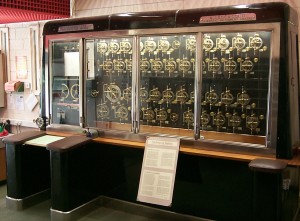About tides – The Doodson-Légé Tide Predicting Machine
Tidal predictions were first carried out in 1924 at Bidston Observatory (University of Liverpool Tidal Institute), initially by hand and then by early tide predicting machines.
 The Doodson-Légé Tide Predicting Machine was designed by a past Director, Dr Arthur T. Doodson and built during 1948–49 by Légé & Co. of London. It was in daily use from then until the early 1960s, when it was superseded by the electronic computer.
The Doodson-Légé Tide Predicting Machine was designed by a past Director, Dr Arthur T. Doodson and built during 1948–49 by Légé & Co. of London. It was in daily use from then until the early 1960s, when it was superseded by the electronic computer.
Before tides for a particular location can be predicted, a series of observed hourly heights, preferably of twelve months duration, are mathematically analysed. This analysis separates the observed tide into its astronomically forced components, known as harmonic constituents or harmonic constants, and is represented by amplitudes and phases. Once this has been done, tides can be predicted for any time in the future or past. An analysis for this machine resolved up to 42 constituents. A modern analysis frequently resolves 120 or more constituents.
On the Doodson-Légé machine there are therefore 42 pulley wheels both on the back and the front, each with the Darwinian names of the constituents they represent. George Darwin, the second son of Charles Darwin, the famous naturalist, was one of the earliest designers of tide predicting machines and gave the constituents their names. Behind each pulley wheel is an adjustable scale for setting the amplitude of the component's motion and its initial phase angle. Each of these was set by the operator to the harmonic amplitude and phase at zero hours, on the first day of January in the year for which the tidal predictions were to be calculated.
The largest pulley wheel on the machine is M2. It is known as the principle lunar semi-diurnal constituent and has the largest amplitude range. It represents the attractive force of the moon (M) on the tide twice a day (2). Similarly, S2 represents the attractive force of the sun (S) on the tide twice a day (2). All the others represent all the other astronomical forces on the tide.
The pulleys are driven simultaneously from a single shaft with a worm drive connected to an electric motor, the same shaft also driving the time scale and day counter. A continuous annealed nickel tape 1mm wide (0.05 mm thick) passes over all the pulley wheels from a fixed point on the top left of the machine, finally re-entering the machine behind the panel in front of the operator.
A duplicate set of pulleys is on the back of the machine, having independent amplitude adjustments which are set proportionally to the velocity (amplitude × frequency) of the components at the front, with a fixed 90° lead-in phase. The two sets of pulleys enabled the simultaneous computation of the times and the heights of the tides.
Once all the angles and amplitudes had been set to the unique set of angles and phases for the port and year to be predicted, the machine was set in motion by the operator. The movement was controlled by means of a foot pedal and a hand wheel. The passage of the cursor past the zero mark on the panel in front of the operator indicated the times and heights of high and low water alternately. The machine would be paused each time the cursor passed the zero mark and the operator noted down the times from the left-hand dial and the heights from the right hand dial.
It took about one and a half days to run a year of tidal predictions, using this method. This included the time it took to set up the amplitudes and phases on the machine, to check and readjust them every three months of machine time, and to write down the table of results as they were read off. Various checking procedures then took place before the results could be published as tide tables. The tides were predicted for much of the world on this machine and its slightly older companion, which is now in the Liverpool Museum.
Modern computers now predict tides, the finished result being produced almost instantaneously.
The Doodson-Légé Tide Predicting Machine is used for occasional demonstration purposes only now, the results comparing very well with those produced by the modern computer.
